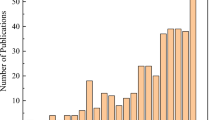Abstract
The authors propose a so-called life-span simulator that can predict concrete structural behaviors under arbitrary external forces and environmental conditions. In order to realize this kind of technology, two computational systems have been developed; one is a thermohygro system that covers microscopic phenomena in C-S-H gel and capillary pores, and the other one is a structural analysis system, which deals with macroscopic stress and deformational field. In this paper, the unification of mechanics and thermo-dynamics of materials and structures has been made with the ion transport of chloride, CO2 and O2 dissolution. This proposed integrated system can be used for simultaneous overall evaluation of structural and material performances without distinguishing between structure and durability.
Résumé
Les auteurs proposent un simulateur qui peut prévoir les comportements structuraux d'un béton (sur toute sa longuer de vie), soumis à des forces extérieures arbitraires et sous un environnement quelconque. Ce simulateur est basé sur le couplage de deux modèles analytiques: un modèle thermohydraulique qui simule les phénomènes microscopiques dans le gel C-S-H et les pores capillaires, et un modèle de structures qui intègre les contraintes macroscopiques et les déformations du béton. Dans cet article, l'association de la mécanique et thermodynamique des matériaux avec l'analyse des structures est réalisée par le transport des ions chlorhydriques, et la dissolution du CO2 et O2. Ce modèle intégré, que nous proposons, peut être utilisé simultanément pour l'évaluation complète des structures et pour l'évaluation des performances des matériaux, sans distinction entre structure et durabilité.
Similar content being viewed by others
References
Maekawa, K., Chaube, R. P. and Kishi, T., ‘Modeling of Concrete Performance’, (E&FN SPON, 1999).
Maekawa, K., Irawan, P. and Okamura, H., ‘Path-dependent three dimensional constitutive laws of reinforced concrete— Formation and experimental verifications,Structural Engineering and Mechanics 15 (6) (1997) 743–754.
Okamura, H. and Maekawa, K., ‘Nonlinear Analysis and Constitutive Models of Reinforced Concrete’, (Gihodo press, Tokyo 1991).
Mabrouk, R., Ishida, T. and Maekawa, K., ‘A Unified Solidification Model of Hardening Concrete Composite’ Proceedings of International Workshop on Control of Cracking in Early age Concrete, Sendai, Japan, 2001.
Mabrouk, R., Ishida, T. and Mackawa, K., ‘A unified solidification model of hardening concrete composite at an early age’,Proc. of the JCI 22 (2) (2000) 661–666
Kishi, T. and Maekawa, K., ‘Multi-component model for hydration heating of Porrland cement’,Concrete Library of JSCE 28 (1996), 97–115.
Kishi, T. and Maekawa, K., ‘Multi-component model for hydration heating of blended cement with blast furnace slag and fly ash’,Concrete Library of JSCE 30 (1997) 125–139.
Chaube, R. P. and Maekawa, K., ‘A permeability model of concrete considering its microstructual characteristics’,Proc. of the JCI 18 (1) (1996) 927–932.
Ishida, T., Chaube, R. P., Kishi, T. and Mackawa, K., ‘Modeling of pore water content in concrete under generic dyring wetting conditions’,Concrete Library of JSCE 31 (1998) 275–287.
Ishida, T., ‘An integrated computational system of mass/energy generation, transport and mechanics of materials and structures’, PhD thesis submitted to University of Tokyo, (1999).
Ishida, T. and Maekawa, K., ‘Modeling of pH profile in pore water based on mass transport and chemical equilibrium theory’,Concrete Library of JSCE 37 (2001) 131–146.
Takeda, H. and Ishida, T., ‘Chlroide binding capacity of cementitious materials based on chemical and electrical factors’,Proc. of the JCI 22 (1) (2000), 133–138.
Takegami, H., Ishida, T. and Maekawa, K., ‘Generalized model for chloride ion transport and equilibrium in blast furnace slag concrete’,Proc. of the JCI 24 (1) (2002) 633–638.
Gjørv, O. E. and Sakai, K., ‘Testing of chloride diffusivity for concrete’, Proc. of the International Conference on Concrete under Severe Conditions, CONSEC95, (1995), 645–654.
Papadakis, V. G., Vayenas, C. G. and Fardis, M. N., ‘Physical and chemical characteristics affecting the durability of concrete’,ACI Material Journal 88 (2) (1991) 186–196.
Freiser, H. and Fermando, Q., ‘Ionic Equilibria in Analytical Chemistry’, (John Wiley & Sons, Inc., 1963).
Saeki, T., Ohga, H. and Nagataki, S., ‘Mechanism of carbonation and prediction of carbonation process of concrete’,Concrete Library of JSCE 17 (1991) 23–36.
West, J. M., ‘Basic corrosion and oxidation’, Second edition (John Wiley & Sons, 1986).
Ishida, T. and Maekawa, K., ‘An integrated computational system for mass/energy generation, transport, and mechanics of materials and structures’,Concrete Library of JSCE 36 (2000) 129–144.
Maruya, T., Tangtermsirikul, S. and Matsuoka, Y., ‘Modeling of chloride ion movement in the surface layer of hardened concrete’,Concrete Library of JSCE 32 (1998) 69–84.
Uomoto, T. and Takada, Y., ‘Factors affecting concrete carbonation ratio’,Concrete Libary of JSCE 21 (1993) 31–44.
Yokozeki, K., Motohashi, K., Okada, K. and Tsutsumi, T., ‘A rational model to predict the service life of RC structures in marine environment’, Forth CANMET/ACI International Conference on Durability of Concrete, SP170-40, (1997) 777–798.
Shimomura, T., ‘Modelling of Initial Defect of Concrete due to Drying Shringkage’, Concrete Under Severe Conditions 2, CONSEC 98, Vol. 3 (1998) 2074–2083.
Nishi, T., Shimomura, T. and Sato, H., ‘Modeling of diffusion of vapor within cracked concrete’,Proceedings of the JCI 21 (2) (1999) 859–864 (In Japanese).
Japan Society of Civil Engineers, ‘JSCE standard construction specification’ (1999).
Okamura, H., Maekawa, K. and Ozawa, K., ‘High Performance Concrete’, Gihodo press, Tokyo, 1993).
Author information
Authors and Affiliations
Rights and permissions
About this article
Cite this article
Maekawa, K., Ishida, T. Modeling of structural performances under coupled environmental and weather actions. Mat. Struct. 35, 591–602 (2002). https://doi.org/10.1007/BF02480352
Issue Date:
DOI: https://doi.org/10.1007/BF02480352




